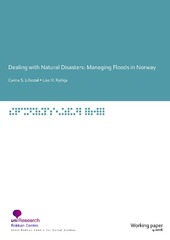| dc.description.abstract | Crises, such as floods, give rise to important political–administrative challenges. Preparing for sudden adversity, and the capacity to respond and adjust course in the face of crises are major and necessary assets for governments. Such government capacities are at the heart of public problem‐solving and include the capacity to coordinate, to regulate, to deliver services and analyze needs and consequences. These capacities can assist governments in their implementation and sustaining of policies for improving crisis management performance. However, different actors may emphasize different capacities and means at different times and in different situations, creating difficulties for learning. This working paper focuses on politics under non‐routine conditions and the generation of governance capacity in crisis management. It presents an empirical case study on floods in Norway, examining two floods (in 2011 and 2013) that took place in Gudbrandsdalen, a valley in the south‐eastern parts of Norway. Extreme rainfall combined with exceptional amounts of snow‐melting in the mountains led to severe flooding in the river of Gudbrandsdalslågen. Two municipalities: Nord‐ Fron and Ringebu lie alongside the river borders and were hit exceptionally hard. Both floods escalated and caused massive destructions in the two municipalities. Evacuation operations and the closing of critical roads made crisis management difficult. In addition to examining this particular case, the working paper aims to provide more general insight about crises and how they are dealt with in the Norwegian context. The paper takes a public policy and organizational perspective to analyze governance capacity in crisis management, with a particular focus on the management of floods. The main research question concerns what government structures and capacities are used in such a crisis, how they function, and how they are modified in the aftermath of a crisis. To this end, the paper examines whether crisis management performance can be said to have improved and to what degree learning from the two floods was gained. The case study provides insight on how two similar incidents (floods) were handled by the same actors, at the same locations, on two different occasions. An important aspect is whether or not the two floods resulted in any structural changes, at central level in the Norwegian Directorate for Civil Protection (DSB) and the Norwegian Water Resources and Energy Directorate (NVE), and at local level in the two municipalities that were affected. In the following, we first present an outline of the case study providing more details on our particular focus. Here, we also explain our approach to the possibilities of learning after a crisis. Second, we present the Norwegian political–administrative context and the main actors responsible for handling the floods. In the next two sections, we lay out our analytical framework, research methods and data. Thereafter, we present our analysis of what happened in the two floods. In the last part of the paper we draw some conclusions about lessons learned and possible policy implications. | en_US |
